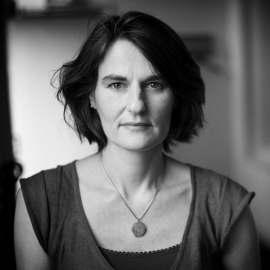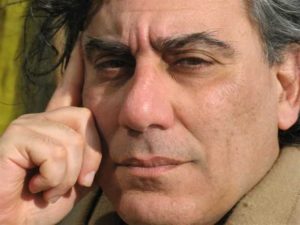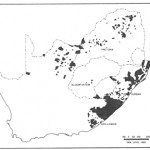Announcement February 2017 ~ Truth or Dare 2017
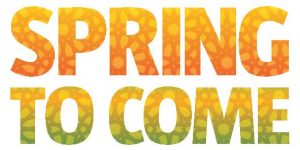 Spring To Come and Metropool International Art Projects/Studio Meritis MaKOM have announced their plans to team up and organise the 2017 festival TRUTH OR DARE.
Spring To Come and Metropool International Art Projects/Studio Meritis MaKOM have announced their plans to team up and organise the 2017 festival TRUTH OR DARE.
Spring to Come is a platform through which researchers, activists and thinkers from the MENA region and Europe aim to explore the best ways forward in creative collaboration and examine the possibility of shaping innovative institutions beyond the current polarized frames. Metropool International Art Projects / Studio Meritis MaKOM is an organisation which stages artistic and cultural activities around core issues currently affecting Europe’s societies, and helps to foster independent thinking, networking and co-production.
Inspired by the success of the first edition of the Spring to Come festival in April 2016, this year we will turn to the urgent subject of ‘truth finding’. The debate on ‘post truth’ society – which currently dominates the news – is not new or an exclusively Western phenomenon. For many citizens in the Middle East and North Africa (the MENA region), living in a ‘post-truth environment’ has been a harsh reality for some time already. In Truth or Dare, we will connect with and draw on this extensive MENA experience with ‘alternative facts’, ‘conspiracy theories’, ‘fake news’, ‘identity politics’ and ‘polarization’ and take it as the starting point for our exchanges, explorations and reflections.
We live in a world in which the biggest loud-mouth seems to get all the attention. Facts, news, truthclaims appear more and more subject to political manipulation and polarization. They turn increasingly into sources of fierce social conflicts. All around, credibility is out of the window. Not much can be taken for granted, anymore. Legitimacy on the basis of experience or expertise is rapidly lost. It is unclear who represents whom or what.
Many public debates focus on the messenger rather than the message; the public outcry more about the ‘tone’ of the debate than about the contents of the debate itself. This is a trend which in itself is also cause of further dispute and polarization.
Paradoxes reign. With the arrival of social media outlets, the public arena looks opener and more accessible than ever. This is, however, deceptive. Not everybody has the same access to media channels. Rapid technological change is accompanies by new inequities, in access to financial possibilities and networks. Besides inequalities in terms of money, power inequalities are also still there. On top of explicit differences in social or political status, people’s public ‘playing field’ is often based on factors which remain more implicit: etnicity, religion, or education. People’s social ‘status’ is no longer so clear-cut.
In Truth or Dare, participants from the MENA region and Europe will engage in an international festival in which we will explore new concepts and ways of thinking together and test alternative, sustainble ways of collaborating. A series of digital publications on post-truth society will be launched in the Rozenberg Quarterly, Studio Meritis MaKOM. Throughout, we will draw on innovative research and artistic expressions.
Contact:
For Spring to Come, Faïrouz ben Salah, Fairouzbensalah@gmail.com
For Studio Meritis MaKOM, Linda Bouws, lindabouws@gmail.com
THIRD REALITY /Manifest for Future Theater/
 For centuries serious efforts of self perception have shown to be unsuccessful. Despite large number of schools and movements, generations of philosophers were unable to neither answer the questions of Antique period nor formulate new ones.
For centuries serious efforts of self perception have shown to be unsuccessful. Despite large number of schools and movements, generations of philosophers were unable to neither answer the questions of Antique period nor formulate new ones.
Moving through labyrinths of time and history we haven’t opened a single new door – we were competing in giving names to the same events.
More and more we kept diverging from the sacred and esoteric.
More and more a considerable part of humanity was living a better life.
More and more we kept stripping ourselves from spirituality.
To be brief and specific we are in the XXI century – in the age when love is based on religion and in the era when the deficit for love has lead us on one hand to spiritual ice age and on the other to global warming.
We live and exist, but where and in which dimension?
Spanish Golden Age playwright Pedro Calderon de la Barca made a following formulation of the historic riddle: Life is a Dream?! /La vida es sueno/.
It is obvious that for centuries there was an idea between the two worlds, offering us paired dimensions:
Existence – Dream
Life – Death
Paradise– Hell
Although religion kept bringing in a third world in the face of purgatory as a third dimension.
Calderon is formulating a question in regard to true reality and our true existence. Is it what we call life or is it what we call a dream? Where does our true meaning lie? When looking at it from a simple perspective, we can merely say that we physically exist in the so-called real life and our consciousness reveals itself in the realm of dreams – which is equally real for our consciousness.
Where can the true essence of a man be found? An essence expressed in antique formulation – “Perceive yourself” /Discover yourself/ or “Be who you are” /Be yourself/.
Here or there? In the so-called life or in a dream? Psychologists may very well say that it is only possible in a realm of dreams.
A new dimension
Development of the world
Interactivity
Resembling the arts – towards stream of consciousness
From Postmodernism to Neo Intellectualism
Recently a friend of mine told me – “An era of Rudolf Steiner /German anthropologist/ and associated with him Postmodernism is coming to an end” and an era of numerous neo-isms? – What should we expect next?
Post, Post, Post?
In the nineties a Spanish theater scholar from Barcelona Jose Angel Gomez widely used and promoted a theory of “Post Theatre”. Hoping for a new theater he wrote articles and books on Post Hamlet, Post Don Juan or the so–called Post Theater issues.
Art research is art philosophy.
Contemporary art historians could already be considered as being culture anthropologists.
From Interactivity to multimedia expression.
Our perception is interactive, which ensures interactivity to be sustained in the process of our self expression – this can only be achieved through means of multimedia.
We exist in number of realities at the same time – one of the most important amongst them is cyber reality – which requires the use of modern technologies as means of self expression.
We listen, watch, reflect, write and read at the same time. In cyber world we tend to interact with several, maybe even ten people at once without them being aware of it. We tend to disguise ourselves in cyber world with fictional biographies, with borrowed individualities and faces.
(Literally – if staring from Antique Theater we were sublimating our desires through an actor or character on stage, today we are the only ones in charge of this process – cyber reality has given us an opportunity to become what we desire and make it not only imaginary but cyber materialistic).
We are paying for a new life (second life – internet space for second reality) and thus our language of expression becomes cyber language – modern technologies of the world of numbers.
Cyber world is a realm with no time and no boarders, no language and no reality. In a sense we exist in a dimension beyond time and reality.
What does an art of this time look like, what are the means of its expression – Theatre – performance becomes a sole tool for the synthesis of arts, human thought and expression of man’s cyber apparitions. Nowadays as never before art is a synthesis.
Process of self expression is limitless, deep and never ending.
We are no longer in the world of news.
We are in the world of a frozen second, where seconds become infinity.
We are no longer in the world of finished works, but in a never ending world of movements, word, sound stretched into space. We are in an era of sending massages into the Universe.
Traditional ways and forms of thinking die out as never before;
Conflict of generations is severe as never before;
Destruction of the world that started in Babylon– finds ways of restoration in cyber world.
We are becoming citizens of cyber world.
We have knowledge of new technologies if not technique – although technique is a single tool for our self expression.
We might very well be at the end of the last decade of printed books – with environmental issues – all books will start dying off in cyber world and find birth in digital form.
We will soon be born and die in cyber world – our existence will set off in space.
Our existence will be infinite.
What will the theater look like now?
INTERACTIVE THEATER
Theater speaks every language at the same time, speaks to everyone without boarders, speaks a language everyone understands – through sound, noise, color, movement, music, light and shadow; image, projection and live broadcasting, in number of directions at the same time, at the same time in entire space.
There is no such thing as a theater space anymore. Space has spread beyond theater walls. It has become limitless. With high technologies, theater becomes more secret and mystical. As never before theater is closest to revealing spirit and thought…
If in the past theater was showing life and people living in it, now theater is more focused on what is happening inside people through life.
It reveals stream of consciousness with its rows of associations and ongoing processes in mind.
Expression of dreams has become a reality, depiction of thought has become real – theater can show our most hidden thoughts, our actions and what we desire to do.
This is only possible through multimedia theater and modern technologies.
Light created colors scattered all over the stage, each corner is transformed into a place of projection – everywhere we see projections of our thoughts and images – we reach deep down into the processes of human’s soul – not through a narrative but through a mere gaze, through penetration in secret labyrinths.
Theater has never been so close to expressing the mystical world – theater becomes global and at the same time very intimate – performance resembles a session of meditation and magnetism.
Theater starts to resemble a visual projection of a mystical world.
Theater starts creating an everyday ritual – theater prays for the universe through revealing human mind.
Light, music, color, noise they all become means of disguising a naked human body.
Nowadays people express themselves through naked bodies instead of words.
Today as never before theater is in need of a new language and this language is a human being – an actor, who can be taken as a measurement unit for a thought transfer in space, a superlative value.
A value of contemporary highly developed civilization – a human being has become an artwork for this very civilization and everything he comes into contact with can just as well become an artwork.
A human being as a measurement unit for freedom, a human being as an example of beauty, a human being as means of nature’s and world’s self expression.
In the world of culture – God is Absolute, which unites all religions despite their name variations, people despite ethnic differences – today God is Absolute – God is art, and art of making, process and result.
Today realities are relative to each other.
Timeline is replaced by one huge infinite dimension, without beginning and end, seconds and minutes are only part of infinity, digital infinity.
Absolute is Zero and plus one, simple truth.
Just one jump from Pythagoras /Greek philosopher/ to the Present.
World is encircled by numbers.
Base of the Universe is Absolute Harmony – Zero and everything undergoes change and creation by simply adding One.
Universe is just Zero and One.
Zero as an infinite Universe and One as every individual in it.
2008-2009, Georgia
Europa: christelijk of humaan?
De vraag zoals die op de aankondiging van deze bijeenkomst staat: Is Europa een christelijk project? is niet in een vacuüm ontstaan. Ik zal eerst kort ingaan op de context van de vraag, waarbij ik die vraag meteen een wat andere richting zal geven.
Aan de hand van drie stellingen zal ik vervolgens toelichten waarom het naar mijn inzicht niet gaat om een christelijk Europa, maar om een humanistisch, of liever gezegd een humaan Europa.
Tenslotte zal ik nog iets zeggen over het karakter van het humanisme dat we vandaag in Europa hard nodig hebben.
De context van de vraag
Het lijkt tegenstrijdig, dat de term christelijke cultuur en zelfs joods-christelijke cultuur weer vaker gebezigd wordt in een tijd dat de christenen steeds duidelijker tot een minderheid behoren, zowel in ons land als in Europa als geheel. Maar bij nader inzien is het niet zo vreemd dat de vraag naar de betekenis van een identiteit sterker klinkt wanneer deze zijn vanzelfsprekende plaats verliest. De onzekerheid die ontstaat door het verlies van macht en aanzien vraagt om bezinning en een nieuwe plaatsbepaling. De kerken zijn volop bezig met deze vragen.
Vreemder is het wellicht, dat degene die de christelijke identiteit het meest luidruchtig verdedigen, mensen zijn die weinig affiniteit vertonen met de christelijke kerken en ook slecht op de hoogte zijn van de recente geschiedenis van het christendom in Europa.
Eén voorbeeld: Geert Wilders spreekt graag en veel van de verdediging van onze vermeende joods-christelijke cultuur om daarmee de islam uit te sluiten als niet-Europees, maar hij lijkt niet te weten dat deze term gemunt is door christelijke theologen die het juist te doen was om de bestrijding van uitsluiting. Zij waren er, kort na de Tweede Wereldoorlog, diep van doordrongen dat christenen medeschuldig waren aan het antisemitisme in Europa, en dus medeverantwoordelijk voor de Shoah. De christelijke theologie mocht haar Joodse wortels nooit meer vergeten of verloochenen. Dat vroeg om een theologische praktijk die antisemitische sporen van bijbellezing en godsdienstonderricht zichtbaar zou maken en de Joodse tradities voortaan in hun interpretaties zou meewegen, om uitsluiting van wie onder het nationaalsocialisme als ‘de anderen’ uitgesloten werden, in de toekomst te voorkomen.
Dat de term joods-christelijk nu juist gebezigd wordt om anderen buiten te sluiten, is een illustratie van de afnemende kennis van de geschiedenis van het christendom in onze samenleving, die gepaard gaat met tal van misverstanden over de relatie tussen geloof en politiek en de betekenis van de scheiding van kerk en staat. (maar dat is een ander verhaal)
De vraag dringt zich, niet voor het eerst in de geschiedenis van Europa op: wie willen we zijn? Naar mijn mening is dát de identiteitsvraag waar we ons voor gesteld zien. Niet zozeer dus: wie zijn we, maar veel meer: wie willen we zijn in de wereld van nu? Wat betekent het mens te zijn in het huidige Nederland, in dit Europa en deze wereld? Valt daarover vanuit de theologie iets te zeggen? Read more
Tunesia Is The Way
 In preparation for a panel discussion ‘Tunisia is the way’ commemorating the five -year anniversary of the Arab Spring in Tunisia, co-sponsored by the Embassy of Tunisia in the Hague, I have been desperately looking for the ‘how to come successfully through a democratic transition period’ manual. I didn’t succeed. Bol.com couldn’t help me, unfortunately. I wished I had finished my political science study.
In preparation for a panel discussion ‘Tunisia is the way’ commemorating the five -year anniversary of the Arab Spring in Tunisia, co-sponsored by the Embassy of Tunisia in the Hague, I have been desperately looking for the ‘how to come successfully through a democratic transition period’ manual. I didn’t succeed. Bol.com couldn’t help me, unfortunately. I wished I had finished my political science study.
Relying on my own resources and rethinking the big and fundamental questions Leiden University has put on the agenda, I found myself confronted with fundamental questions. The title for example suggests an option, a choice between several ways, but for the majority of the people, Tunisia is the only way. For them, international comparisons are highly irrelevant. Moreover, the question arises; ‘the way to what?’
The introduction makes it clear that we are talking about a democratic transition, thus defining the uprisings as political in the first place. But is this so? To what extent is the outcome as the activists have striven towards?
The introduction seems to correspond with the dominant view in the beginning, especially in ‘our part of the world’, that the Arab region was entering a period of democratic transitions, which would take weeks or months in each country and remain relatively peaceful, ushering in a new regional era of electoral democracy.
From this still very popular perspective, the revolts were the result of a cultural and political mutation born of a new generation connected to global culture, thanks to the new information and communication technologies. According to this view, the uprisings were essentially, if not exclusively, a struggle for political freedom and democracy.
This vision is not completely off the mark, off course. But, I would like to add an other point of view to the discussion. I will try to show that the upheavals were social and economic rather than political. The uprisings and the aftermath have brought underlying social developments to a surface. I will emphasize that these developments are to a large extent similar to those in other parts of the world.
Since the start of the great financial crisis in 2007, western Europe seems to be in a continuing crisis. Apart from the financial crisis we were facing consecutively: a bank crisis, a Euro crisis, the Greek crisis, a sustainability crisis, an institutional crisis, a migrant crisis and nowadays people are talking about a refugee crisis.
I don’t want suggest that the current challenges are fully comparable or underestimate the major issues Tunisia has to deal with. Not at all. But I do believe that the long term developments have a common undertow, which I would define as the occurrence of new dividing lines in combination with a massive conflict of old powers.
This is not a historical exception. Worldwide there are, for example, many similarities in the feminist struggles during the 20 s of the previous century. The so called first feminist period.
On this point, I feel the need to make a strong disclaimer. I am not a sociologist nor a political scientist. Today I am sharing my personal observations.
Read more
On Friendship / (Collateral Damage)
From text we came and to text we shall return
Beeldend kunstenaar Joseph Semah denkt, werkt en becommentarieert in de traditie van zijn grootvader Hacham Sassoon Kadoori, de laatste Opperrabbijn van de Babylonische joden in Bagdad. Hacham Sassoon Kadoori, president van de joodse gemeenschap, was een groot voorstander en verdediger van tolerantie tussen de verschillende religies. Hij geldt nog steeds als een lichtend voorbeeld voor de jongere generatie Joden met een Iraakse achtergrond.
Semahs oeuvre kan gezien worden als voortzetting van dit gedachtegoed. Hij gebruikt zijn achtergrond als een manier om naar de westerse cultuur te kijken. Hij verbindt daartoe kunst, filosofie, religie, en wetenschap met elkaar. Zijn ideeën en visies brengt Semah naar buiten in teksten, tekeningen, sculpturen, schilderijen, performances en vanzelfsprekend ook in projecten die onderling sterk zijn verbonden.
“I still read each and every art work on display through the tradition/history of the Hebrew language. In this context, one can say that each art work of mine is nothing but a footnote to my research, to my desire to understand what contemporary art actually means, what is meant by tolerance, what the meaning of being in exile is and what it means to be a guest”.
In Semahs werk zijn jodendom, christendom, islam en humanisme de religieuze, seculiere en culturele stromingen die de westerse identiteit mee bepalen.
In On Friendship / (Collateral Damage) onderzoekt de kunstenaar de claim van een steeds grotere groep opiniemakers die zich beroept op de Joods-christelijke oorsprong van de Europese cultuur. Aan de hand van voorbeelden uit de hedendaagse, beeldende kunst analyseert Semah in hoeverre aan de Joodse invloeden werkelijk aandacht wordt besteed in het kunstdebat. Hij gaat in op de specifiek Joodse lading in werken van Kazimir Malevich (Het naakte onverheelde vierkant) en Barnett Newman (Read Full Text). Op persoonlijke en intrigerende wijze laat Semah zien hoe de Hebreeuwse taal, en dus Joodse traditie en cultuur, van invloed was – direct of indirect – op deze kunstenaars, wier werk een iconische status heeft gekregen in de westerse kunstgeschiedenis.
Semah komt tot de conclusie dat de Joodse betekenislaag te weinig aandacht krijgt en te vaak wordt genegeerd in de hedendaagse kunstgeschiedenis. Of wordt die laag vermeden om ongemakkelijke confrontaties in een naoorlogse, getraumatiseerde samenleving uit de weg te gaan?
Studeren, analyseren, becommentariëren, toevoegen en het gesprek beginnen is in de opvatting van Semah echter hoogstnoodzakelijk. Semah denkt en werkt in de traditie van de Babylonische Talmoed. Semah vult de lege pagina en maakt de Joodse cultuur, traditie en identiteit in een andere culturele omgeving zichtbaar. Hij vraagt ons opnieuw te kijken naar onze eigen cultuur, samenleving en identiteit en dat kan verontrustend werken en roept verwarring op.
Over vriendschap (bijschade)
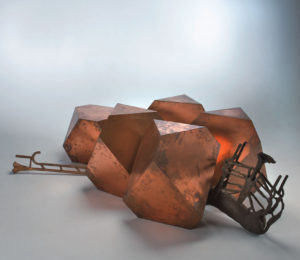
Joseph Semah: Notes from the diary of the architect, 1987. Copper and bronze, 80 cm – Foto: Rüdiger Lubricht
Vaak, en ergens tussen zorg en pijn in, heb ik proberen te begrijpen hoe bijschade moet aanvoelen, te beseffen wat afstandelijke taal betekent, en meer proberen te weten te komen over onze schilderkunst – i.e., elk doek dat tot stand is gekomen volgens de regels van het westers paradigma – door, om zo te zeggen, de afwezigheid van conflictgedrag in het museale domein aan de orde te stellen.
Dat vormt zodoende het begrippenkader waarbinnen de specifieke problemen rond de belofte van iedere kunstenaar zich afspelen.
Om te beginnen:
bijschade is realiteit.
Het is de gegevenheid van de ‘Made-Ready’, een tekst die gelezen moet worden, steeds een bedenksel van de menselijke geest. Als dat anders zou zijn, dan zou de beschilderde oppervlakte van onze doeken vertekend zijn, afgekeurd worden en niet langer in staat iets te betekenen.
Het doek dat getoond wordt, is daarom in zekere zin een vorm van bevestiging van het gedachtegoed binnen het westers paradigma. Een ideologie die begint aan gene zijde van de wanhoop.
In deze openingsscène zitten we dus op de eerste rij met kunstenaars die zich grotendeels onbewust zijn van hun plicht, die niet anders kunnen dan hun eigen belofte schilderen terwijl ze ondertussen heimelijk gecontroleerd worden, aangestuurd en geënsceneerd door een onopgemerkte kracht. We bevinden ons, met andere woorden, in gezelschap van kunstenaars die geleid worden door die verborgen hand van het westers paradigma – die onzichtbare manipulatieve kracht die nog steeds veel dieper onder de oppervlakte van onze doeken duikt dan kunstenaars ooit bevroedden.
Voor zover we nu weten heeft de CIA, i.e. de Central Intelligence Agency, in het geheim naoorlogse Amerikaanse abstracte doeken gebruikt als onderdeel van zijn activiteiten in de Koude Oorlog. Dit heeft geduurd vanaf ongeveer 1950 tot 1960. Bovendien heeft de CIA, nagenoeg verborgen voor de meeste kunstenaars die erbij betrokken waren, die naoorlogse Amerikaanse abstracte doeken naar het centrum van de belangstelling geschoven, als een soort strategische vloerbedekking, om op die manier als het ware de vernielde bodem van het naoorlogse Europa toe te dekken. En tot slot van dit spel horen we dat dit heimelijk bedekken met doeken plaatsvond onder de codenaam ‘Long Leash’ (De vrije teugel).
We moeten dus langzamerhand gaan accepteren dat de Amerikaanse kunstenaars zich niet van de acties van de CIA bewust waren, en tegelijkertijd ons afvragen hoeveel leden van ‘The Congress for Cultural Freedom’ op dezelfde manier bedrogen werden door de CIA. Read more
